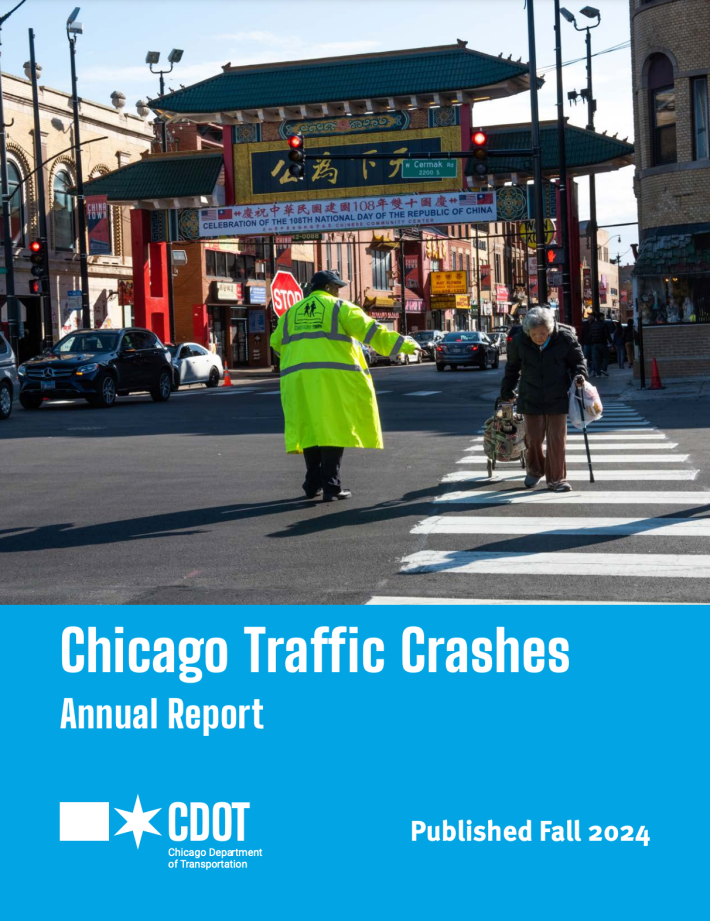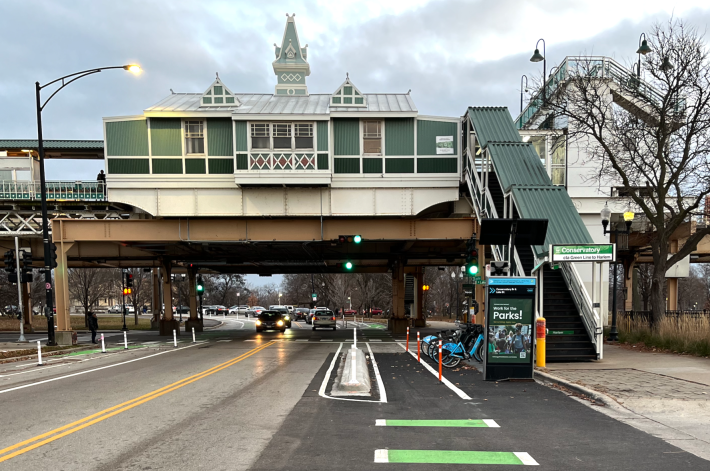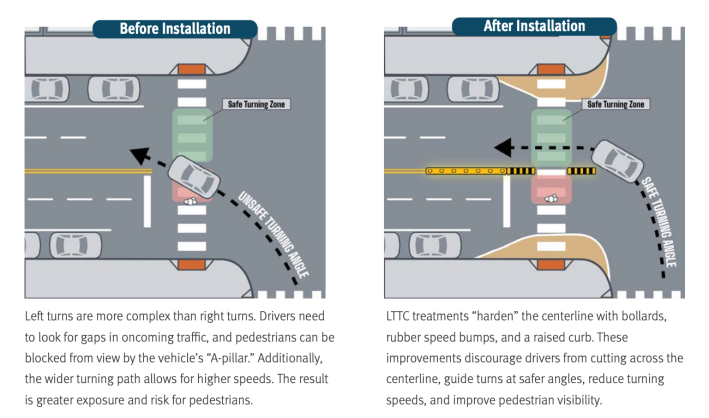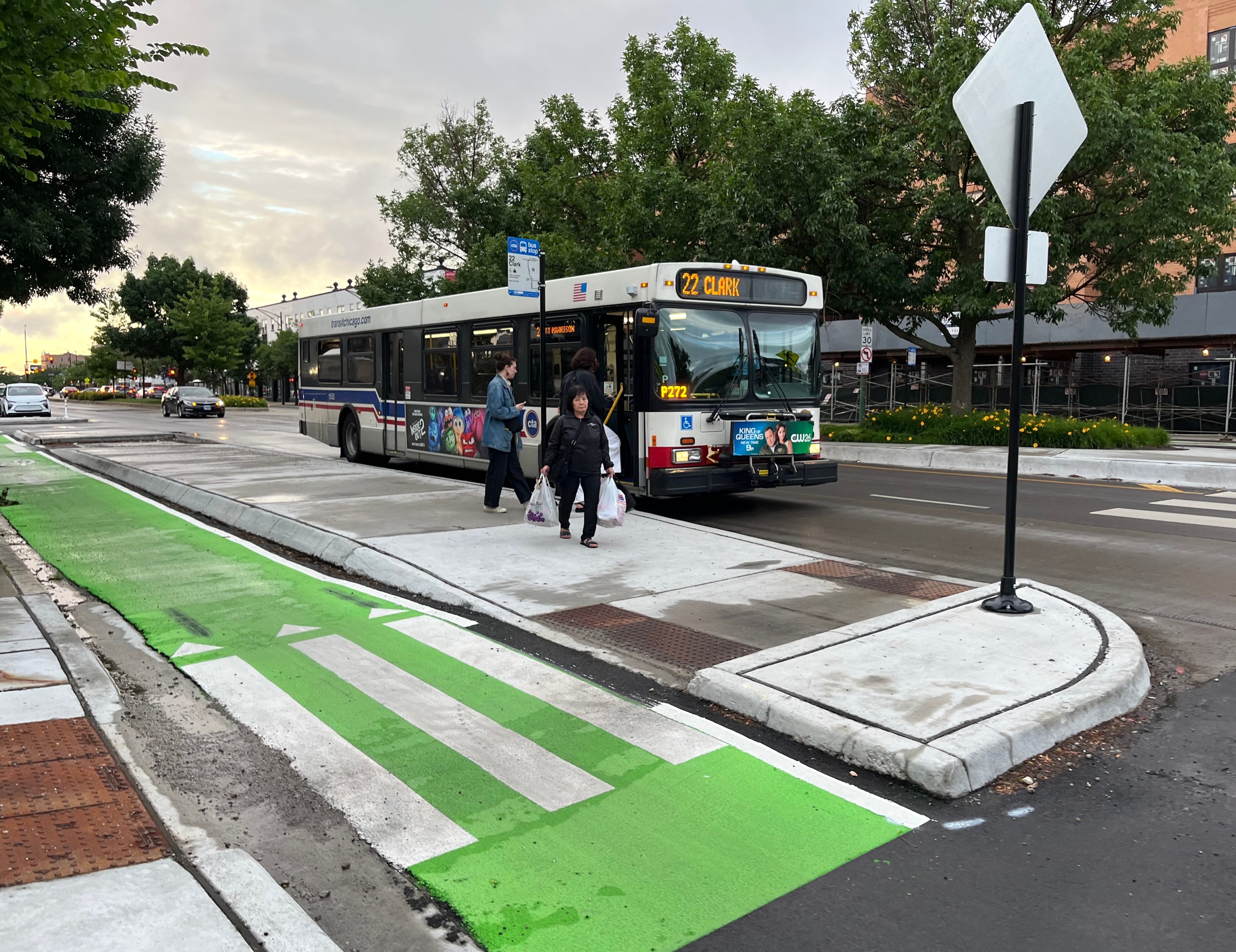
A new report from the Chicago Department of Transportation has some encouraging news about the effects of roadway improvements on traffic safety. Thanks to investment in traffic calming and bike/pedestrian safety infrastructure, Chicago recorded a 27 percent decline in traffic deaths in 2023, down from a peak of more than 180 roadway fatalities in 2021.
The news, detailed in CDOT’s annual report on traffic crashes, may come as no surprise to advocates. After all, their lobbying for for traffic calming measures and policy changes helped pave the way (so to speak) for the sweeping installation of protected bike lanes, bus boarding islands, raised crosswalks and other bike/ped infrastructure over the last two years. The city made major investments in road safety, installing more than 50 miles of low-stress bikeways as part of the 2023 Chicago Cycling Strategy. A dramatic drop in the number of bike riders killed by drivers immediately followed. Chicago also enjoyed an impressive 119 percent jump in bicycling over the last four years, a bigger increase than any major U.S. city.

Crash data, collected by the Chicago Police Department and analyzed by CDOT in the report, backs up what common sense would predict. Slowing down drivers, physically separating people on bikes from drivers, and increasing the visibility of vulnerable road users leads to a reduction in serious and fatal crashes. This data also helps CDOT identify crash trends and prioritize new projects.
The report lists three key issues that contributed to 136 people killed or seriously injured in traffic crashes in 2023. These include the size and speed of vehicles involved, reckless driving, and racial and economic disparities in which Chicagoans are most exposed to traffic violence.
Regarding the first issue: Streetsblog USA has been sounding the alarm on the deadly effects of "car bloat," increasingly large models, for some time. And while the city can do little to prevent Chicagoans from buying ever bigger and heavier trucks and SUVs, it can discourage drivers from speeding in these potentially lethal mega-vehicles. Protected bike lanes, curb bump-outs, pedestrian islands, and bus boarding islands not only protect and improve visibility of all road users, but also narrow travel lanes and discourage drivers from speeding.

One example of this design in action is the protected bike lanes and pedestrian islands installed on Jackson Boulevard between Austin and Central avenues. According to the report, speeding violations decreased by a dramatic 75 percent and speeding decreased 60 percent after the bikeway was installed. This led to a 25 percent decrease in crashes overall and zero pedestrian or bicyclist deaths on the corridor. Lives of vulnerable road users were saved and fewer tickets were issued to motorists.
The new protected bike lanes and raised crosswalks on Central Park Avenue by the Garfield Park Conservatory had a similar effect. Post-installation, Central Park experienced a 59 percent reduction in speeding in an area where many families are traveling to public attractions, like the "Gold Dome" field house and the Garfield Park Conservatory on foot or bicycle. With any luck, a new ordinance to decrease Chicago’s default speed limit from 30 mph to 25 mph will pass later this year and further reduce the number of deaths caused by speeding drivers.

Reckless driving, the second key issue, is also reined in by good road design. According to the report, 84 percent of traffic fatalities in 2023 were caused by egregious driving behavior, like passing on the shoulder or left-turn lane, and running red lights. Right-sizing travel lanes and bracketing them with protective parking and curb bump outs prevents reckless drivers from passing on the shoulder or striped medians.
CDOT also found that crashes caused by left-turning drivers were common and more likely to result in serious injuries or deaths of pedestrians struck in a crosswalk. New yellow rubber speed bumps and bollards can be found running down the centerline of select roads near intersections. These interventions tighten the turning angle of left-turning drivers, forcing them to slow down.

CDOT piloted the left turn traffic calming measures at five intersections in River North in 2019. Since installation, the area saw a 24 percent reduction in crashes. The report also states that the portion of drivers yielding to pedestrians increased from 73 percent to a near-utopian 94 percent. These mid-road yellow speed bumps are appearing at more high-crash intersections: 65 have been completed or are slated to be installed by the end of this year.
The third issue, tragic inequalities in traffic fatalities, is related to the first two. In Chicago, four times more Black residents were killed in traffic crashes than all other residents. Data also showed that older Chicagoans are the most vulnerable, with residents aged 70 and older experiencing the highest rate of death from traffic violence.
A heat map showing the density of severe crashes illustrates how majority-Black neighborhoods are most impacted by traffic violence. Outside of the traffic-dense central business district, the West Side neighborhoods of Austin, Garfield Park and North Lawndale, along with the Greater Grand Crossing on the South Side, have the highest concentration of crashes that result in severe injury or death. These areas also have sparse pedestrian, bicycle and traffic-calming infrastructure.

CDOT uses crash data and an index measuring mobility and economic hardship to prioritize future traffic safety investments. Amongst these is the deadly stretch of Pulaski Road between 40th and 71th streets, where five vulnerable road users have been killed since 2023. School zones in high-crash areas on the South and West Sides are also slated for improvemecnts.
While the CDOT report is encouraging, there's much work to do for Chicago to approach the Vision Zero goal, eliminating all serious and fatal crashes. The data in the report is irrefutable evidence that lower-stress bikeways and safe pedestrian accommodations are an effective and necessary investment in public safety.
Read CDOT’s new Chicago Traffic Crashes report here.

Did you appreciate this post? Please consider making a tax-deductible donation, to help keep Streetsblog Chicago's sustainable transportation news and advocacy articles paywall-free.





